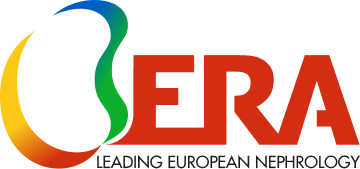Monoclonal gammopathy of unknown significance in kidney transplanted patients
Do you know your ABCDE profile?
Do you know your ABCDE profile?
All men over 40 and all women after menopause or over 50 should know their ABCDE profile. ‘A’ stands for ‘albuminuria’, ‘B’ for ‘blood pressure’, ‘C’ for ‘cholesterol’, ‘D’ for ‘diabetes’ and ‘E’ for ‘eGFR status’. The ABCDE profile can be extended with ‘F’ for ‘fat’, and ‘N’ for ‘nicotine’. The ABCDE profile not only helps to identify the risk for kidney failure, but also for cardiovascular diseases. The precise prognoses are intended to encourage patients and doctors to take preventive measures at an early stage. Because, for both heart and kidney failure, the earlier these diseases are detected, the better they can be treated.
A complex interplay of heart and kidney
New research developments tend to no longer consider heart and kidney failure as two separate diseases because every second heart failure patient also has chronic kidney disease and many patients with chronic renal failure also have a weak heart. Depending on the origin, we often speak of a ‘cardiorenal’ or ‘renocardiac’ syndrome (originating from the Latin ‘ren’). The interaction of the heart and kidneys is however much more complex, so ‘nephrocardiology’ is now the preferred term in the medical field. Nephrocardiologists no longer focus on the triggering organ, but on the dominant clinical picture, which must be treated first.
The estimated glomerular filtration rate (eGFR) is an important marker
But to what extent do the heart and kidney weaken each other? A weak heart pumps poorly and does not supply the kidney with sufficient blood. The glomeruli filter less primary urine from the blood, resulting in a reduced glomerular filtration rate (GFR). GFR is covered by the ‘E’ in the ABCDE profile. The ‘E’ stands for “estimated” – ‘e’GFR. The GFR is estimated based on serum creatinine, age, gender and skin colour. The normal value is 90 to 130 millilitres per minute. The kidney reacts to this undersupply of blood by releasing more of the hormone-like renin. This boosts the circulation again, increases the blood pressure and thus also the filtration pressure in the kidneys. At the same time, the renin-angiotensin-aldosterone system (RAAS) is activated. The RAAS constricts the vessels, blood pressure and blood volume continue to rise and with them the pressure on the heart and kidneys.
Very few people know or feel that their heart or kidneys are failing because the symptoms are initially non-specific. Particularly the kidneys suffer silently, and kidney disease is not accompanied by any pain. The ERA therefore fully supports that the European Society of Cardiology (ESC) recommends in its new guidelines to always include markers for kidney disease when screening for cardiovascular risk factors. “This means that the ESC recognizes chronic kidney disease as a strong and independent risk factor for cardiovascular disease,” emphasizes Prof. Dr Christoph Wanner, Head of Nephrology at the University Hospital of Würzburg and President of the ERA. Until recently, the invisibility of chronic kidney disease as a clinical diagnosis has been a major obstacle to the implementation of strategies to reduce cardiovascular risk. For example, in a Swedish cohort of more than 50,000 people with kidney disease, only 23 per cent had an actual diagnosis registered by the treating physician in the electronic health records.
Albumin determination with UACR test
In addition to the eGFR, early detection of incipient kidney damage is also possible and important through the determination of the protein ‘albumin’ in the urine. It’s crucial to know that kidney damage can be stopped, but not reversed. A quick urine test with a classic urine strip already gives the first indications. “Even more accurate is a UACR test (Urine Albumin to Creatinine Ratio). The laboratory test measures the ratio of albumin and creatinine concentrations in the urine,” Christoph Wanner explains. “Ideally, every family doctor, diabetologist and cardiologist should regularly offer this very simple and clean laboratory test. The patient brings a previously distributed urine tube of their morning urine to the doctor.”
Of course, it is equally important to clarify the cardiovascular risk in kidney patients. Cardiovascular complications in patients with renal failure are often of greater concern to physicians than renal complications only. Ultimately, most kidney patients do not die because of their renal failure, but from a cardiovascular event.
Additional information
Same therapeutic approach for heart failure, renal failure and hypertension
ACE inhibitors and angiotensin receptor blockers as well as angiotensin receptor neprilysin inhibitors (ARNI) are often prescribed for heart failure, kidney failure and high blood pressure. They inhibit the renin-angiotensin-aldosterone system, dilate the vessels and lower blood pressure. With SGLT2 inhibitors, another type of drug has now been included in the health care guidelines. They are a new groundbreaking treatment against heart failure and kidney insufficiency. They were originally developed for diabetes therapy but not only help against high blood sugar, but they also slow down the progression of heart and kidney failure, even in the absence of diabetes. SGLT2 inhibitors ensure that more sugar – about ten teaspoons per day – is excreted through the urine. This lowers the blood sugar level in people with diabetes, more sodium and water are excreted and it can lead to a slight decrease in weight and blood pressure. At the same time, the pressure within the kidney filtering bodies is reduced and this decisively relieves the kidneys and circulation.
